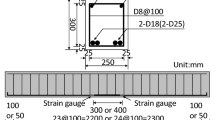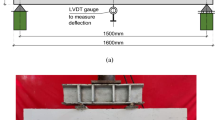Abstract
Splice strength of deformed steel bars embedded in recycled aggregate concrete was experimentally investigated using 48 bottom-cast scaled splice beam specimens detailed with unconfined contact lap splices and tested under four-point bending. The following variables were investigated: concrete grade (normal- and medium-strength), recycled concrete aggregate replacement level (0, 50 and 100%), rebar diameter (12 and 20 mm), splice length (15 and 25 d b), rebar surface characteristics and concrete cover to rebar diameter (c/d b = 1.25 and 2). Bond behaviour and failure modes were noted to be similar in the natural and in the recycled aggregate concrete and a regression analysis of the results shows that f′ 3/4 c provides a good representation of the influence of recycled aggregate concrete grade on splice strength. A descriptive bond strength equation has been proposed for recycled aggregate concrete and it is noted that the MacGregor model (for conventional concrete) gave relatively the most accurate and conservative bond strength predictions for the recycled aggregate concretes under investigation. Bond strength is predicted based on analytical model available in literature.








Similar content being viewed by others
References
Harajli MH, Salloukh KA (1997) Effect of fibers on development/splice strength of reinforcing bars in tension. ACI Mater J 94(4):317–324
Chenglin Wu, Chen G, Volz JS, Brow RK, Koenigstein ML (2013) Global bond behavior of enamel-coated rebar in concrete beams with spliced reinforcement. Constr Build Mater 40:793–801
Hamad SB, Harajli MH, Jumaa G (2001) Effect of fiber reinforcement on bond strength of tension lap splices in high strength concrete. ACI Struct J 98:638–647
Esfahani MR, Rangan BV (1999), Bond between high-performance concrete (HPC) and reinforcing bars in splices of beams. ACI Special Publication
Aly R (2007) Stress along tensile lap-spliced fiber reinforced polymer reinforcing bars in concrete. Can J Civ Eng 34(9):1149–1158
ACI (American Concrete Institute) (2003) ACI 408R-03: bond and development of straight reinforcing bars in tension. American Concrete Institute, Farmington Hills
Zuo J, Darwin D (2000) Splice strength of conventional and high relative rib area bars in normal and high-strength concrete. ACI Struct J 97(4):630–641
Kozul R, Darwin D (1997) Effect of aggregate type, size and content on concrete strength and fracture energy. Structural Engineering and Engineering Materials SM Report No.43, University of Kansas center for Research, INC. Lawrence, Kansas
Ajdukiewicz A, Kliszczewicz A (2002) Influence of recycled aggregates on mechanical properties of HS/HPC. Cement Concr Compos 24:269–279
Xiao J, Falkner H (2007) Bond behaviour between recycled aggregate concrete and steel rebars. Constr Build Mater 21:395–401
Corinaldesi V, Moriconi G (2009) Influence of mineral additions on the performance of 100% recycled aggregate concrete. Constr Build Mater 23(8):2869–2876
Huang Q, Wang D (2011) Experimental study on bond-slip between steel bar and recycled aggregate concrete. Adv Build Mater 250–253:1651–1656
Choi HB, Kang KI (2008) Bond behaviour of deformed bars embedded in RAC. Mag Concr Res 60(6):399–410
Seara-Paz S, González-Fonteboa B, Eiras-Lo´pez J, Herrador MF (2014) Bond behavior between steel reinforcement and recycled concrete. Mater Struct 47(1–2):323–334
Bai G, Wu S, Li X (2010) Investigation of bond-slip behaviour between recycled concrete and steel bars under pullout test. In: Xiao JZ, Zhang Y, Cheung MS, Reuben PKC (eds) Proceedings of the 2nd international conference on waste engineering and management ICWEM 2010, 13–15 October 2010, Shanghai, China. RILEM Publications SARL, France, pp 628–637
Butler L, West JS, Tighe SL (2011) The effect of recycled concrete aggregate properties on the bond strength between RCA concrete and steel reinforcement. Cem Concr Res 41:1037–1049
Kim Y, Sim J, Park C (2012) Mechanical properties of recycled aggregate concrete with deformed steel re-bar. J Mar Sci Technol 20(3):274–280
Guerra M, Ceia F, De Brito J, Júlio E (2014) Anchorage of steel rebars to recycled aggregates concrete. Constr Build Mater 72:113–123
Breccolotti M, Materazzi AL (2013) Structural reliability of bonding between steel rebars and recycled aggregate concrete. Constr Build Mater 47:927–934
Prince MJR, Singh B (2015) Bond behaviour of normal and high-strength recycled aggregate concrete. Struct Concr 16(1):56–70
Zhao Y, Lin H, Wu K, Jin W (2013) Bond behaviour of normal/recycled concrete and corroded steel bars. Constr Build Mater 48:348–359
Morohashi N, Sakurada T, Yanagibashi K (2007) Bond splitting strength of high-quality recycled coarse aggregate concrete beams. J Asian Archit Build Eng 6:331–337
Tepfers R (1973) A theory of bond applied to overlapping tensile reinforcement splices for deformed bars. PhD Thesis. Division of concrete structures, Chalmers University of Technology, Göteborg, Sweden, Publication 73(2)
Orangun CO, Jirsa JO, Breen JE (1975) The strength of anchored bars: a reevaluation of test data on development length and splices. Center for Highway Research, The University of Texas at Austin, Texas, Research Report No. 154-3F
Orangun CO, Jirsa JO, Breen JE (1977) A reevaluation of test data on development length and splices. ACI J 74(3):114–122
Darwin D, Tholen ML, Idun EK, Zuo J (1996) Splice strength of high relative rib area reinforcing bars. ACI Struct J 93(1):95–107
Esfahani MR, Vijaya Rangan BV (1998) Bond between normal strength and high-strength concrete (HSC) and reinforcing bars in splices in beams. ACI Struct J 95(3):272–280
Zsutty T (1985) Empirical study of bar development behavior. J Struct Eng, ASCE 111(1):205–219
Zuo J, Darwin D (1998) Bond strength of high relative rib area reinforcing bars. University of Kansas Center for Research, Lawrence, p 46
Butler L, West J, Tighe S (2014) Bond of reinforcement in concrete incorporating recycled concrete aggregates. J Struct Eng, ASCE, doi:10.1061/(ASCE)ST.1943-541X.0000928
BIS (Bureau of Indian Standards) (1989) IS 8112:1989 (Reaffirmed 2005). 43 Grade ordinary Portland cement–Specification. Bureau of Indian Standards, New Delhi
BIS (Bureau of Indian Standards) (1970) IS 383:1970 (Reaffirmed 2002). Specification for coarse and fine aggregates from natural sources for concrete. Bureau of Indian Standards, New Delhi
BIS (Bureau of Indian Standards) (2007) 2386(Part IV):1963 (Reaffirmed 2007). Methods of test for aggregates for concrete–Part IV Mechanical properties. Bureau of Indian Standards, New Delhi
Nagataki S, Gokce A, Saeki T, Hisada M (2004) Assessment of recycling process induced damage sensitivity of recycled concrete aggregates. Cem Concr Res 34:965–971
BIS (Bureau of Indian Standards) (2005) IS 456:2000 (Reaffirmed 2005). Plain and reinforced concrete—Code of practice. Bureau of Indian Standards, New Delhi
Harajli M, Abouniaj M (2010) Bond performance of GFRP bars in tension: experimental and assessment of ACI 440 guidelines. J Compos Constr 14(6):659–668
ACI (American Concrete Institute) (2014) ACI 318-14: Building code requirements for structural concrete (ACI 318-14) and commentary. American Concrete Institute, Farmington Hills
MacGregor JG (1997) Reinforced concrete: mechanics and design, 3rd edn. Prentice-Hall, New Jersey, pp 290–301
Steele AR (2014) Bond performance of recycled aggregate concrete. Masters Theses Missouri, Institute of Science and Technology
van der Veen C (1990) Cryogenic bond stress-slip relationship. Ph.D. Dissertation, Department of Civil Engineering, Delft University of Technology, Stevinweg
Acknowledgements
The work reported in the manuscript was funded by research grants made available by the first author’s host institute.
Author information
Authors and Affiliations
Corresponding author
Ethics declarations
Conflict of interest
The authors declare that there is no conflict of interest regarding the publication of this paper.
Rights and permissions
About this article
Cite this article
Gaurav, G., Singh, B. Bond strength prediction of tension lap splice for deformed steel bars in recycled aggregate concrete. Mater Struct 50, 230 (2017). https://doi.org/10.1617/s11527-017-1101-z
Received:
Accepted:
Published:
DOI: https://doi.org/10.1617/s11527-017-1101-z




